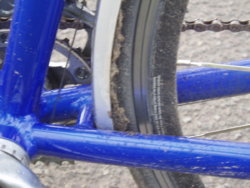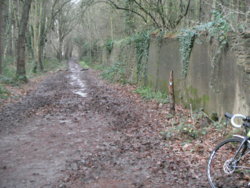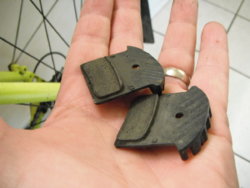Had a similar situation with my MTB - was out with BiL and was having problems because I couldn't control speed with V-Brakes due to a combination of cold weather and muddy wet trails - no problems with the brakes just they weren't slowing me down particularly well. Swapped to discs on the same bike and not had a problem since.Out mountain biking in early 1990’s , friend shot down a long steep rocky descent and we were all in awe of his skills and bravery. Caught him up and turns out his cantilever brakes were full on the whole time
luckily everyone else had vbrakes and was fine
You are using an out of date browser. It may not display this or other websites correctly.
You should upgrade or use an alternative browser.
You should upgrade or use an alternative browser.
Page may contain affiliate links. Please see terms for details.
Kajjal
Guru
- Location
- Wheely World
I found the same on my First MTB I got with vbrakes after using cantilever brakes beforehand. On my first ride pulled them on hard and took off over the handlebars. When I switched to disc brakes the level of power and control was way better in all conditions compared to vbrakes.Had a similar situation with my MTB - was out with BiL and was having problems because I couldn't control speed with V-Brakes due to a combination of cold weather and muddy wet trails - no problems with the brakes just they weren't slowing me down particularly well. Swapped to discs on the same bike and not had a problem since.
Vantage
Carbon fibre... LMAO!!!
- Location
- Behind everyone else, Bolton
Mid 90's I was a member of Bolton Mountain Bikes (named after the shop)RIP) and we regularly went to races around the north of England, cross country and downhill. One member asked the owner his secret to going downhill fast.
His answer was to just let go of the brakes. Brilliant! That helped.
His answer was to just let go of the brakes. Brilliant! That helped.

- Location
- Somewhere wet & hilly in NW England.
Disc brakes every time for me.
There is a hill not too far from where I live which is about 350m in length and varies between 15 - 26% - sadly I can only just about get up the thing.
Descending:
Old bike: TRP CX 8.4 Linear Pull shod with Ashima Tri-compound pads will not completely stop me in the DRY and take an age to get to that point. These are properly set up and out performed a friends Ultegra rim brakes so they are very good for rim brakes.
New bike: 105 Hydro's. Stop me smoothly and without any drama very quickly in the WET.
That's a good enough reason for me to love discs.
NB: I've ridden around 20k miles on MTB's (way back) in some very crap conditions too and they never skipped a beat - all big S.
There is a hill not too far from where I live which is about 350m in length and varies between 15 - 26% - sadly I can only just about get up the thing.

Descending:
Old bike: TRP CX 8.4 Linear Pull shod with Ashima Tri-compound pads will not completely stop me in the DRY and take an age to get to that point. These are properly set up and out performed a friends Ultegra rim brakes so they are very good for rim brakes.
New bike: 105 Hydro's. Stop me smoothly and without any drama very quickly in the WET.
That's a good enough reason for me to love discs.
NB: I've ridden around 20k miles on MTB's (way back) in some very crap conditions too and they never skipped a beat - all big S.
Kajjal
Guru
- Location
- Wheely World
You're just spoilt nowDisc brakes every time for me.
There is a hill not too far from where I live which is about 350m in length and varies between 15 - 26% - sadly I can only just about get up the thing.
Descending:
Old bike: TRP CX 8.4 Linear Pull shod with Ashima Tri-compound pads will not completely stop me in the DRY and take an age to get to that point. These are properly set up and out performed a friends Ultegra rim brakes so they are very good for rim brakes.
New bike: 105 Hydro's. Stop me smoothly and without any drama very quickly in the WET.
That's a good enough reason for me to love discs.
NB: I've ridden around 20k miles on MTB's (way back) in some very crap conditions too and they never skipped a beat - all big S.

Ming the Merciless
There is no mercy
- Location
- Inside my skull
Fitted XT hydros to my new recumbent today. Only rim braked bike I have left is my Brompton. Like @SpokeyDokey I've had over 20 years experience of hydros on my mtn bike and they haven't missed a beat either.
SkipdiverJohn
Deplorable Brexiteer
- Location
- London
MTB's aren't pretty so discs are fine there.
Modern MTB's are ugly, which is one of the reasons I don't like them and won't buy them. Discs won't make them look any worse I agree. I wouldn't ruin the appearance of an 80s or 90's steel framed one with discs though!
fossyant
Ride It Like You Stole It!
- Location
- South Manchester
Modern MTB's are ugly, which is one of the reasons I don't like them and won't buy them. Discs won't make them look any worse I agree. I wouldn't ruin the appearance of an 80s or 90's steel framed one with discs though!
Thing is, you are missing out if you fancy going faster or tackling much more difficult terrain other than pottering about.
SkipdiverJohn
Deplorable Brexiteer
- Location
- London
Thing is, you are missing out if you fancy going faster or tackling much more difficult terrain other than pottering about.
I'm perfectly happy pottering about on fairly tame terrain, and since I'm not interested in racing, I couldn't care less that riding a rim-braked fully rigid MTB means I'm slower than a modern disc-braked machine with suspension.
I suspect the overwhelming majority of riders who take their bikes off-tarmac are also just pootlers and are not trying to squeeze the last bit of speed out of their ride. The newer stuff does have advantages in certain situations, but I'm not into that sort of riding, much preferring to carefully pick my way through a route without coming off - even if that means being slow.
Grant Fondo
Legendary Member
- Location
- Cheshire
In grimy cold wet weather the difference between old cantis and new hydraulic discs is massive....akin to the drum brakes on a 1960 Morris Minor i had vs my current 2016 BMW. I am all in favour of technology when it actually works.
fossyant
Ride It Like You Stole It!
- Location
- South Manchester
In grimy cold wet weather the difference between old cantis and new hydraulic discs is massive....akin to the drum brakes on a 1960 Morris Minor i had vs my current 2016 BMW. I am all in favour of technology when it actually works.
Quite, and the only thing I'm wearing out in sloppy weather is cheap pads, not wheels.
Richard A Thackeray
Legendary Member
My CGR has RS505 (hydraulic) 'brifters', acting on RS785 Calipers
They're operating onto Clarke 'Dirt Dissipation' discs, according to the order history (just checked)
My thoughts & the 'back history' are......………...….
I'd had hydraulics on a (2007) Trek 6000 MTB, & realised how effective they were in bad conditions, and how powerful they could be! (enough to make the front tyre tread 'squirm' under heavy road-braking (mainly as experiments)
I was using a '7005 - blue - winter - audax' (seems to have different names at times?!), & whilst it was, & still is, a nice bike to ride, it had a trio of main problems.....
(it was bought in June 2013, to replace a 20 year old Dyna-Tech 755Ti that had been downgraded to commuter)
1. It could only take '23' section tyres, with mudguards, & I'd clogged them up on a couple of rides, just with road-silt!
(I'd thought I was getting tired/running out of energy, till I heard the noise )
)

2. Given the state of a few sections of road on my commute, & indeed regular ride-routes, a larger air-chamber would be nice (see point 1)
3. Brake wear was as much a problem as the low-clearances, with an average of 2 pairs of brake-blocks per year
So, with that in mind, in early 2017 I started to look for a succesor
I'd been given clearance my Senior Management to buy a new bike (as she, & daughter were having 3 holidays that year)
Ribble had recently announced the CGR, so I looked at that (given the 'customisation' available)
I'd seen one, whilst calling at 'Squires', but couldn't ask for a ride, as it was a much larger frame size
So, I took the plunge & ordered, which was delayed due (at the time, if I remember) to no RS505 'brifters' in the country
On first ride what was noticed was;
1. The lightness of braking, due to not 'dragging' the inner-cable through the outer (which can degrade over age)
2. Full compression, ie; all effort is applied to the caliper, no stretching the inner-cable, whilst at the same time compressing the outer cable
3. Compared to the cantilevers on my CX bike, some of the effort on that, can go to deforming the seat-stays (a), on heavy braking (or in bad conditions)
4. The controllability/sensitivity of braking
5. The larger air-chamber tyres, allow a more comfortable ride, maybe at lower pressures - on a greasy surface?
(Schwalbe Durano PP, on mine)
6. More mudguard clearance, as mine is sometimes used in woods/bridleways, such as here, at Haw Park Woods (Waterton Park)

Secondary thoughts were;
My wheels will last longer, due to
- rims not wearing, with brake application (b)
- sealed bearings, even means hubs lasting longer (as with the Aksyiums, on my CGR)
- larger (air-chamber) tyres that can be used, protect the rim against potholes
- if a pothole is hit, & breaks a spoke/dents a rim, the brakes will still work (or not rub)
So, it's really a 'Win-Win Situation', as wheels last longer, with better all weather braking
Whist there are counter-issues with pad-heat, & the possible 'blueing' of discs, & they do get hot!!!, rotors can't be made out of aluminium (like a rim) as they'd not last)
The size of a rim, does help to dissipate any heat almost instantly in most conditions (especially in this country - not many Alpine passes to descend)
Fork strengthening is definitely required, due to the point of force-application being so far away, in terms of leverage from the crown
a; Even my Pace Research RC100, many years ago, with its Magura hydraulic (rim) brakes, could 'bend' those square section seat-tubes!!!
b; Pad wear, obviously does happen, but this was at about 13 - 14 months, with 'all weather' use
Granted, yes, I could have got more wear out of them, but the lever travel had increased to more than I liked

They're operating onto Clarke 'Dirt Dissipation' discs, according to the order history (just checked)
My thoughts & the 'back history' are......………...….
I'd had hydraulics on a (2007) Trek 6000 MTB, & realised how effective they were in bad conditions, and how powerful they could be! (enough to make the front tyre tread 'squirm' under heavy road-braking (mainly as experiments)
I was using a '7005 - blue - winter - audax' (seems to have different names at times?!), & whilst it was, & still is, a nice bike to ride, it had a trio of main problems.....
(it was bought in June 2013, to replace a 20 year old Dyna-Tech 755Ti that had been downgraded to commuter)
1. It could only take '23' section tyres, with mudguards, & I'd clogged them up on a couple of rides, just with road-silt!
(I'd thought I was getting tired/running out of energy, till I heard the noise
 )
)
2. Given the state of a few sections of road on my commute, & indeed regular ride-routes, a larger air-chamber would be nice (see point 1)
3. Brake wear was as much a problem as the low-clearances, with an average of 2 pairs of brake-blocks per year
So, with that in mind, in early 2017 I started to look for a succesor
I'd been given clearance my Senior Management to buy a new bike (as she, & daughter were having 3 holidays that year)
Ribble had recently announced the CGR, so I looked at that (given the 'customisation' available)
I'd seen one, whilst calling at 'Squires', but couldn't ask for a ride, as it was a much larger frame size
So, I took the plunge & ordered, which was delayed due (at the time, if I remember) to no RS505 'brifters' in the country
On first ride what was noticed was;
1. The lightness of braking, due to not 'dragging' the inner-cable through the outer (which can degrade over age)
2. Full compression, ie; all effort is applied to the caliper, no stretching the inner-cable, whilst at the same time compressing the outer cable
3. Compared to the cantilevers on my CX bike, some of the effort on that, can go to deforming the seat-stays (a), on heavy braking (or in bad conditions)
4. The controllability/sensitivity of braking
5. The larger air-chamber tyres, allow a more comfortable ride, maybe at lower pressures - on a greasy surface?
(Schwalbe Durano PP, on mine)
6. More mudguard clearance, as mine is sometimes used in woods/bridleways, such as here, at Haw Park Woods (Waterton Park)

Secondary thoughts were;
My wheels will last longer, due to
- rims not wearing, with brake application (b)
- sealed bearings, even means hubs lasting longer (as with the Aksyiums, on my CGR)
- larger (air-chamber) tyres that can be used, protect the rim against potholes
- if a pothole is hit, & breaks a spoke/dents a rim, the brakes will still work (or not rub)
So, it's really a 'Win-Win Situation', as wheels last longer, with better all weather braking
Whist there are counter-issues with pad-heat, & the possible 'blueing' of discs, & they do get hot!!!, rotors can't be made out of aluminium (like a rim) as they'd not last)
The size of a rim, does help to dissipate any heat almost instantly in most conditions (especially in this country - not many Alpine passes to descend)
Fork strengthening is definitely required, due to the point of force-application being so far away, in terms of leverage from the crown
a; Even my Pace Research RC100, many years ago, with its Magura hydraulic (rim) brakes, could 'bend' those square section seat-tubes!!!
b; Pad wear, obviously does happen, but this was at about 13 - 14 months, with 'all weather' use
Granted, yes, I could have got more wear out of them, but the lever travel had increased to more than I liked

Last edited:

